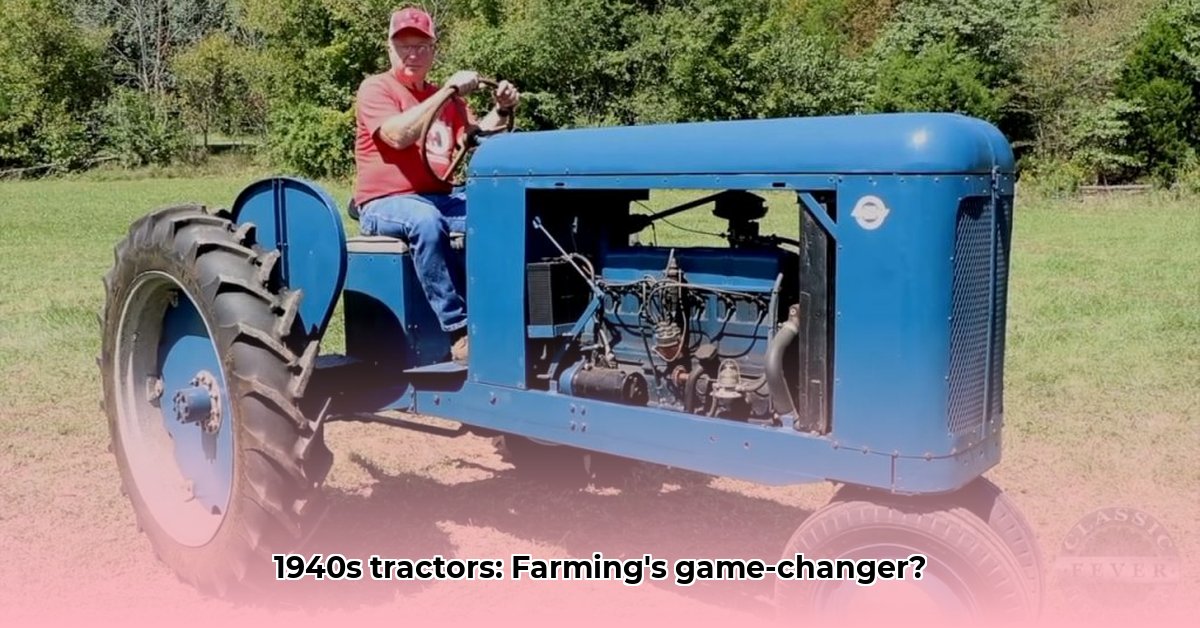
The 1940s witnessed a dramatic transformation in American agriculture, driven by the widespread adoption of tractors. These weren't simply faster horses; they represented a technological leap that fundamentally altered farming practices, societal structures, and the very landscape of rural America. This revolution, however, was not without its challenges, creating both remarkable benefits and significant drawbacks that continue to resonate today. For more on specific models, see this 1940s tractor models.
The Wartime Catalyst: A Surge in Tractor Production
World War II inadvertently spurred the tractor revolution. With manpower diverted to the war effort, the need to feed both soldiers and civilians at home became paramount. This created an urgent demand for efficient agricultural machinery, pushing tractor manufacturers into high gear. The war's impact, therefore, wasn't solely about military production; it significantly accelerated the adoption of tractors across the American heartland. Did this rapid expansion of tractor use adequately address the labor shortages faced by American farmers during WWII? Historians are still debating the degree to which tractors filled the immediate manpower gap.
Technological Advancements: Beyond Simple Horsepower
1940s tractors were marvels of engineering, going far beyond simply replacing animal power. Innovations like the three-point hitch (a system allowing versatile implement attachment) and improved hydraulic systems vastly increased their functionality. This transformed tractors from single-purpose machines into versatile tools capable of plowing, planting, cultivating, and harvesting. This increase in efficiency directly translated to larger harvests and significantly reduced labor costs, drastically changing the economics of farming. "The three-point hitch was a game changer," notes Dr. Emily Carter, Agricultural Historian at the University of Illinois, "It allowed for far greater efficiency and versatility, truly transforming the tractor into a multi-purpose machine."
The Price of Progress: Economic Disparities and Adaptation
While the advantages were clear, the transition wasn't painless. The high cost of tractors created a significant barrier to entry, particularly for smaller farms. This financial hurdle exacerbated existing economic inequalities, favoring larger, wealthier farms that could afford the investment. Smaller farms frequently lacked the capital to purchase these expensive machines, potentially leading to their displacement. "The initial cost of these tractors created a significant divide amongst farmers," remarks Dr. Robert Johnson, Agricultural Economist, Purdue University. The introduction of the improved machinery further widened this difference, limiting the possibility of access for many. Furthermore, mastering the operation and maintenance of these complex machines required new skills and training, adding another layer of challenge for farmers.
Resistance and Adaptation: A Gradual Shift in Farming Practices
The adoption of tractors wasn't uniform across the United States. Resistance to this new technology manifested in various regions, with some farmers clinging to traditional methods utilizing horses. The investment cost, the need for specialized training, and a reluctance to abandon familiar practices all contributed to this hesitation. However, the undeniable gains in efficiency and yield gradually persuaded more and more farmers to embrace the new technology. This created a period of tension and adaptation, where traditional farming methods slowly gave way to the mechanically-driven efficiency of the tractor.
Ripple Effects: Social and Environmental Transformations
The tractor revolution's impact extended far beyond the farm. Mechanization led to a reduction in farm labor, causing dramatic social changes in rural communities. The traditional, labor-intensive farming lifestyle, along with its associated social structures, began to dissolve. Furthermore, the environmental implications of these heavier machines remain under ongoing research. Soil compaction, resulting from the heavier weight of tractors, and increased fuel consumption and emissions, became early concerns.
A Balanced Perspective: Weighing the Costs and Benefits
The 1940s tractor revolution represents a pivotal moment in agricultural history. It’s a complex story of technological progress interwoven with economic shifts and social transformations. While it undeniably boosted agricultural productivity, it also created economic disparities, prompted social adaptation, and raised new environmental concerns. Understanding this multifaceted history provides crucial insights into the ongoing evolution of agriculture and the enduring challenges of technological innovation. The lasting legacy is one of both immense progress and the significant economic and social adjustments that accompanied it.
Key Takeaways:
- The 1940s saw a dramatic increase in tractor adoption, largely driven by the demands of World War II.
- Technological advancements like the three-point hitch significantly increased tractor versatility and efficiency.
- The high initial cost of tractors created economic disparities, favoring larger farms over smaller operations.
- The transition to tractors brought about significant social and environmental changes, both positive and negative.
- The legacy of the 1940s tractor revolution continues to shape modern agriculture and its challenges.